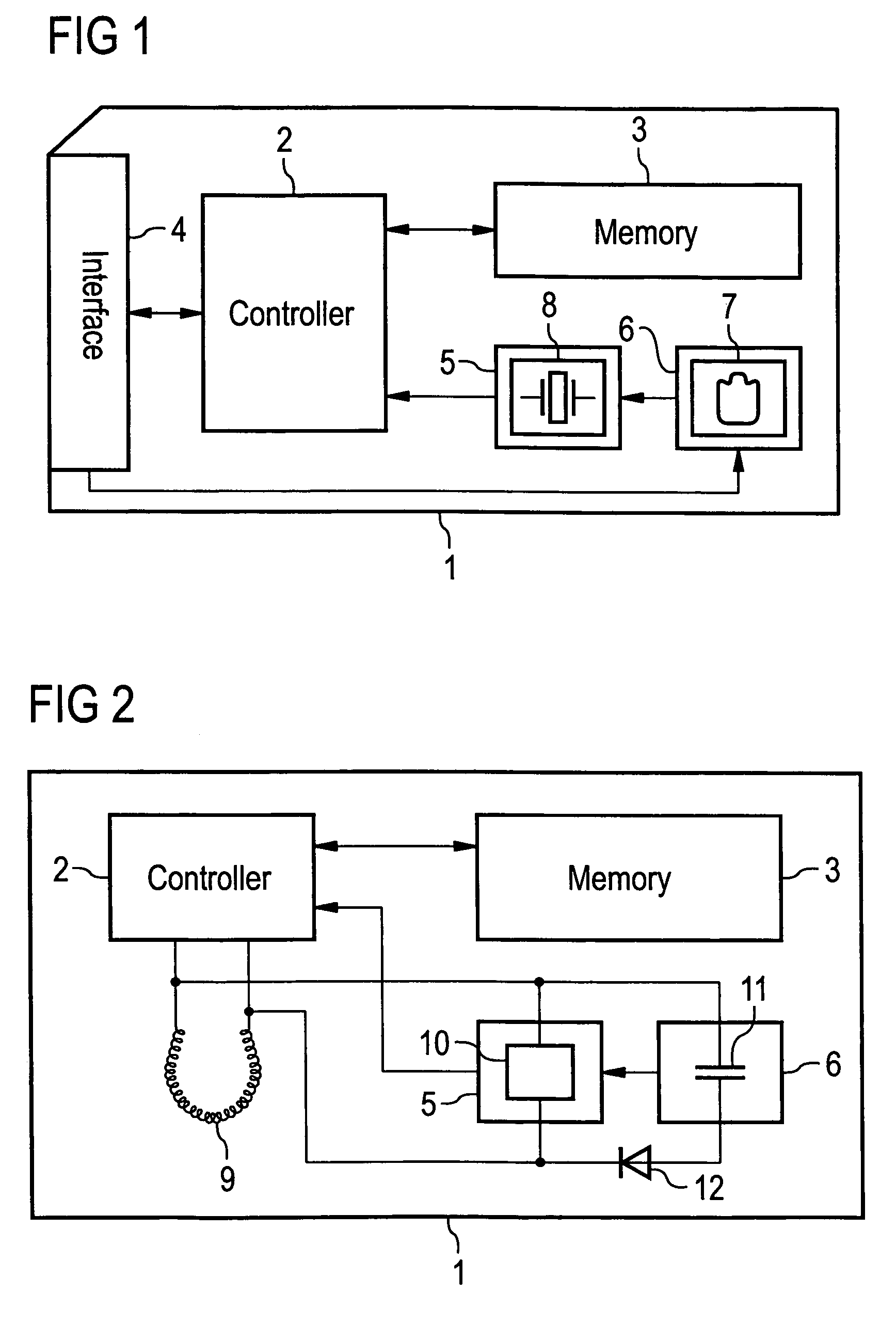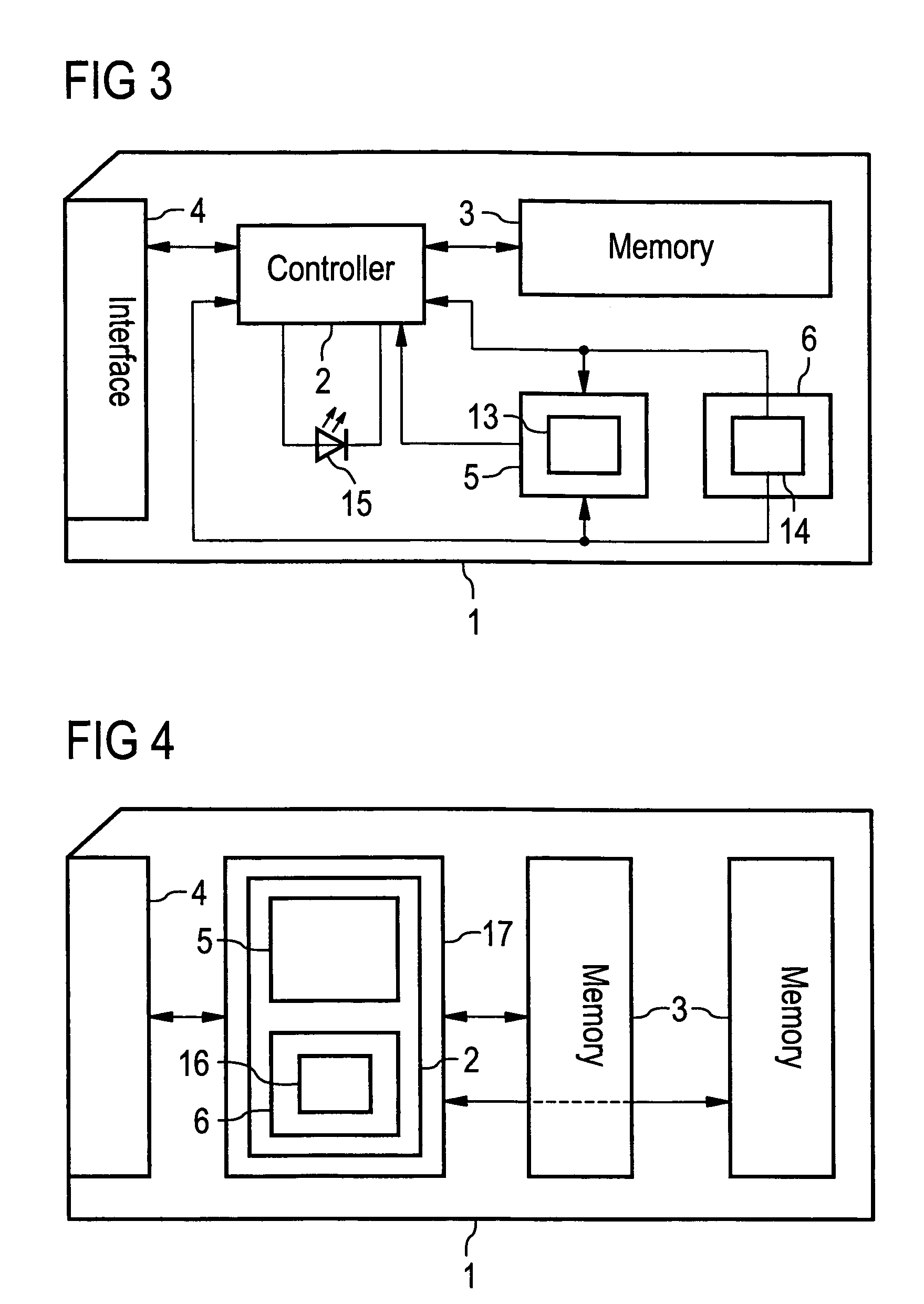Non-volatile memory card with autarkic chronometer
hronometer technology, applied in the field of semiconductor devices and methods, can solve the problems of hard to enforce the deactivation of a non-volatile memory card at the end of the expected lifetime, memory cards degrade with time, and many customers do not read such information, and achieve the effect of easy detection
- Summary
- Abstract
- Description
- Claims
- Application Information
AI Technical Summary
Benefits of technology
Problems solved by technology
Method used
Image
Examples
first embodiment
[0025]FIG. 1 shows the present invention. A memory card 1, for example an xD-Picture Card, a SmartMedia (SM) card or a Memory Stick (MS), comprises a controller 2 and a non-volatile memory module 3. The memory card 1 further comprises an interface 4 for the exchange of data with an external, electronic device such as a host computer (not shown). The controller 2 is connected to the memory module 3 and the interface 4 and controls the data exchange between the memory module 4 and the external, electronic device. The interface 4 is implemented using contacts for forming an electrical connection for transmitting data and power from and to the host system.
[0026]The memory card 1 further comprises a chronometer 5 and a power supply 6. The power supply 6 comprises an energy store, in the exemplary embodiment given by a battery 7. In the exemplary embodiment the battery 7 is rechargeable and is connected to the interface 4. The battery 7 has a capacity large enough to supply the chronomete...
second embodiment
[0031]FIG. 2 shows the present invention. The exemplary embodiment shows a memory card 1, for example a radio frequency identity (RFID) card, comprising a controller 2 and a non-volatile memory module 3. As in the last embodiment, the memory card 1 comprises a power supply 6 and a chronometer 5. Unlike the last embodiment, the memory card 1 does not provide an electrical interface to directly connect the memory card 1 to an external, electrical device. Instead, the memory card 1 comprises an antenna 9, which serves as the interface and allows to couple the memory card 1 wirelessly to an external, electrical device.
[0032]In addition, the chronometer 5 contains a time receiving module 10, which is connected to the antenna 9 and configured to receive the current time from a publicly available time signal. An example of such a publicly available time signal is the long wave radio signal emitted by the DCF 77 radio transmitter, which provides the current date and time in the Middle Europ...
third embodiment
[0037]FIG. 3 shows the present invention. A memory card 1, for example a USB Flash drive or a Compact Flash (CF) card, comprises a controller 2, a non-volatile memory module 3, an interface 4 for connecting the memory card 1 to an external, electrical device, a chronometer 5 and a power supply 6. The chronometer 5 comprises a decay time measurement unit 13, which is capable of estimating the time based on an observed decay process of a chemical compound or element, for example a radioactive substance. The power supply 6 comprises a solar cell 14 and a rechargeable battery 7 (not shown). The memory card 1 further comprises a signaling element 15, in the example of the present embodiment a light emitting diode (LED), connected to the controller 2. The power supply 6 provides the chronometer 5 and the controller 2 with electrical energy.
[0038]Because in this exemplary embodiment the controller 2 is powered by the power supply 6, the controller 2 can operate independently from an extern...
PUM
 Login to View More
Login to View More Abstract
Description
Claims
Application Information
 Login to View More
Login to View More - R&D
- Intellectual Property
- Life Sciences
- Materials
- Tech Scout
- Unparalleled Data Quality
- Higher Quality Content
- 60% Fewer Hallucinations
Browse by: Latest US Patents, China's latest patents, Technical Efficacy Thesaurus, Application Domain, Technology Topic, Popular Technical Reports.
© 2025 PatSnap. All rights reserved.Legal|Privacy policy|Modern Slavery Act Transparency Statement|Sitemap|About US| Contact US: help@patsnap.com



